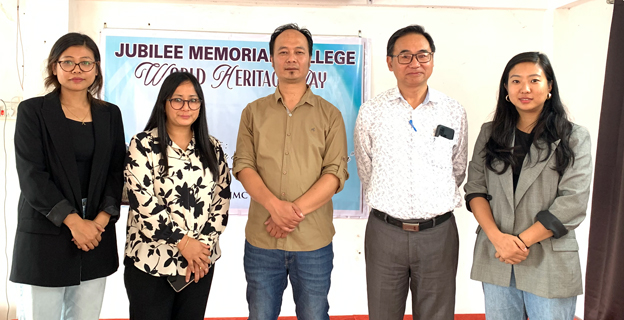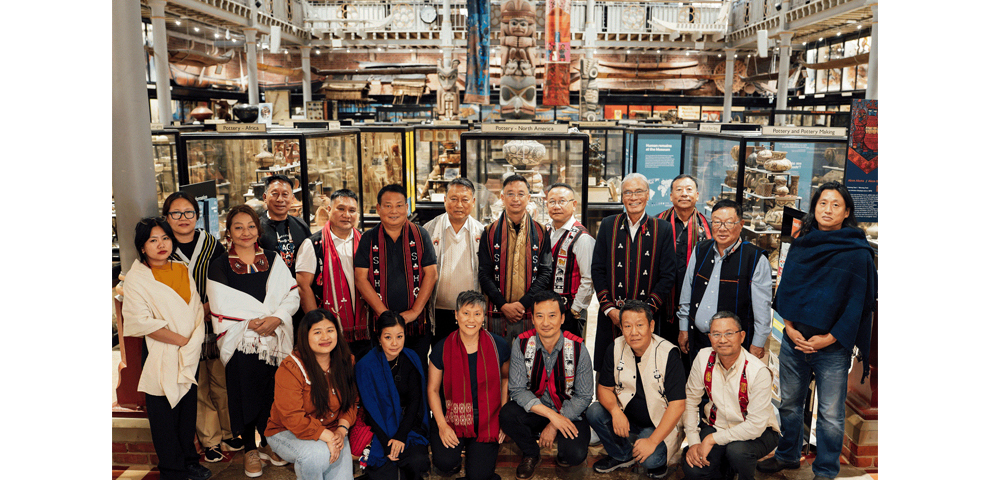Mokokchung, 17 April (MTNews): The Jubilee Memorial College (JMC) Mokokchung on Wednesday celebrated World Heritage Day, organized by the Department of History, JMC with Limalenden Longkumer, editor of Mokokchung Times as the guest speaker.

The guest speaker emphasized the significance of embracing one’s culture, identity, and heritage. Speaking passionately about the importance of authenticity, he urged individuals to equip themselves with indigenous traditional knowledge along with the academic.
“What is heritage?” Longkumer posed, distinguishing between two primary types: Natural heritage encompassing land, air, rivers, and ecosystems, and Cultural heritage, which includes both tangible and intangible elements. He highlighted the emergence of digital and built heritage in contemporary times.
“Our village is not merely a geographical location, postal address or a residential area,” he declared, stressing the village’s role as the cornerstone of identity for Naga and other indigenous communities. “For us, it’s the foundational basis of our identity,” he added, encouraging students to maintain a strong connection with their native villages.
On preservation of heritage, he said that one cannot preserve something that is extinct and that efforts must be made before any heritage is lost.
Acknowledging the pervasive influence of global cultures like Bollywood, Hollywood, and K-pop, Longkumer questioned how individuals can navigate these influences without losing their cultural identities. He cautioned against media distortions and emphasized the importance of self-awareness and active engagement.
Highlighting the challenges faced by tribal communities in India, Longkumer cited efforts by fundamentalist groups like the RSS to ‘edit’ history and redefine tribal indigenous religions as forms of Hinduism. “We must be aware and active,” he urged.
Turning his attention to language, Longkumer challenged perceptions that indigenous languages are inferior dialects. “Your mother tongue is not inferior,” he asserted, emphasizing the importance of preserving and celebrating linguistic diversity.
Longkumer also defended traditional agricultural practices like jhum cultivation, refuting the mainstream narrative that portrays it as inferior. “Our culture revolves around agriculture, our heritage is largely based on agriculture,” he proclaimed, underscoring the importance of respecting and preserving traditional farming methods and values associated with it.
Longkumer further encouraged individuals to reconnect with their roots by visiting their villages, engaging with elders, and participating in heritage preservation efforts. “It all comes down to what you have in your mind,” he concluded, urging everyone to be proactive in defending and promoting their cultural heritage.
The event was chaired by Imkongrenla and a welcome address was delivered by Dr Imtiwati Jamir, Principal of JMC. Students of the college also preformed a folk fusion song.
Morung model exhibition
In commemoration of World Heritage Day, students of the History Department undertook a unique initiative to raise awareness about heritage preservation while promoting sustainability.
They collaborated to create traditional Naga morung models using entirely recycled and waste materials, symbolizing the fusion of tradition and innovation in heritage conservation.
Throughout the crafting process, students researched the historical significance of morungs in different Naga cultures, deepening their understanding of cultural heritage and the importance of preserving indigenous traditions.

The completed morungs were displayed prominently on campus today, accompanied by informative posters highlighting the significance of World Heritage Day and the role of heritage conservation in promoting sustainable development. Altogether, nine morungs were being exhibited.



kamagra oral jelly: Kamagra Commander maintenant – Kamagra pharmacie en ligne
Tadalafil 20 mg prix en pharmacie: Cialis sans ordonnance 24h – Tadalafil 20 mg prix en pharmacie tadalmed.shop
Pharmacie en ligne Cialis sans ordonnance: Achat Cialis en ligne fiable – Tadalafil sans ordonnance en ligne tadalmed.shop
vente de mГ©dicament en ligne: pharmacie en ligne fiable – pharmacie en ligne fiable pharmafst.com
Cialis sans ordonnance 24h: Cialis sans ordonnance 24h – Cialis sans ordonnance pas cher tadalmed.shop
acheter mГ©dicament en ligne sans ordonnance: pharmacie en ligne – vente de mГ©dicament en ligne pharmafst.com
pharmacie en ligne pas cher: Pharmacies en ligne certifiees – pharmacie en ligne sans ordonnance pharmafst.com
Achat mГ©dicament en ligne fiable: Meilleure pharmacie en ligne – Pharmacie Internationale en ligne pharmafst.com
Acheter Kamagra site fiable: achat kamagra – Kamagra pharmacie en ligne
pharmacies en ligne certifiГ©es: Medicaments en ligne livres en 24h – pharmacie en ligne france pas cher pharmafst.com
kamagra en ligne: kamagra oral jelly – Kamagra Oral Jelly pas cher
pharmacie en ligne avec ordonnance: Livraison rapide – Pharmacie Internationale en ligne pharmafst.com
Achat Cialis en ligne fiable: Cialis sans ordonnance 24h – Cialis sans ordonnance pas cher tadalmed.shop
Kamagra pharmacie en ligne: kamagra pas cher – Acheter Kamagra site fiable
Tadalafil 20 mg prix sans ordonnance: Acheter Cialis 20 mg pas cher – cialis prix tadalmed.shop
Kamagra Oral Jelly pas cher: achat kamagra – achat kamagra
pharmacie en ligne pas cher: Pharmacies en ligne certifiees – pharmacie en ligne pharmafst.com
Cialis sans ordonnance 24h: cialis sans ordonnance – Pharmacie en ligne Cialis sans ordonnance tadalmed.shop
Cialis generique prix: cialis generique – cialis sans ordonnance tadalmed.shop
india pharmacy mail order: indian pharmacy – indian pharmacy online shopping
adderall canadian pharmacy: Express Rx Canada – canada pharmacy world
indian pharmacy online: mail order pharmacy india – indian pharmacy
indian pharmacy: indian pharmacy – Medicine From India
canadian drugs pharmacy: Express Rx Canada – my canadian pharmacy
indian pharmacy online shopping Medicine From India indianpharmacy com
medicine courier from India to USA: medicine courier from India to USA – indian pharmacy
indian pharmacy online shopping: top 10 online pharmacy in india – indian pharmacy paypal
mexico drug stores pharmacies: mexican online pharmacy – mexico drug stores pharmacies
Medicine From India: medicine courier from India to USA – MedicineFromIndia
cross border pharmacy canada: Express Rx Canada – canadian pharmacy antibiotics
pharmacy website india best india pharmacy Medicine From India
mexico pharmacy order online: mexico pharmacies prescription drugs – RxExpressMexico
Rx Express Mexico: mexico pharmacies prescription drugs – mexico drug stores pharmacies
india online pharmacy top 10 pharmacies in india medicine courier from India to USA
pinup az: pin up casino – pin up
pin up: pin up – pinup az
вавада: vavada casino – vavada casino
пин ап вход: пин ап казино официальный сайт – pin up вход
pin up azerbaycan: pin-up – pin up az
пин ап вход: пин ап казино – пин ап казино официальный сайт
пин ап казино официальный сайт: пинап казино – pin up вход
пин ап вход: пин ап казино официальный сайт – pin up вход
пин ап казино официальный сайт: пин ап казино официальный сайт – pin up вход
пинап казино: пин ап казино официальный сайт – пин ап казино официальный сайт
пин ап казино официальный сайт: пин ап зеркало – пин ап казино официальный сайт
pin up casino: pin-up casino giris – pin up azerbaycan
вавада казино: вавада зеркало – вавада зеркало
vavada: вавада казино – вавада зеркало
пинап казино: пин ап казино официальный сайт – пин ап зеркало
pinup az: pin-up – pin-up casino giris
order Cialis online no prescription: online Cialis pharmacy – Cialis without prescription
modafinil legality: buy modafinil online – modafinil legality
best price Cialis tablets: order Cialis online no prescription – reliable online pharmacy Cialis
fast Viagra delivery: generic sildenafil 100mg – discreet shipping
safe online pharmacy: secure checkout Viagra – buy generic Viagra online
safe online pharmacy: discreet shipping – discreet shipping
trusted Viagra suppliers: no doctor visit required – generic sildenafil 100mg
http://maxviagramd.com/# legit Viagra online
secure checkout Viagra: fast Viagra delivery – fast Viagra delivery
Viagra without prescription: safe online pharmacy – same-day Viagra shipping
buy generic Cialis online: buy generic Cialis online – cheap Cialis online
generic tadalafil: cheap Cialis online – Cialis without prescription
buy modafinil online: doctor-reviewed advice – doctor-reviewed advice
http://maxviagramd.com/# order Viagra discreetly
reliable online pharmacy Cialis: discreet shipping ED pills – reliable online pharmacy Cialis
https://maxviagramd.shop/# generic sildenafil 100mg
modafinil pharmacy: verified Modafinil vendors – Modafinil for sale
generic tadalafil: buy generic Cialis online – Cialis without prescription
PredniHealth: PredniHealth – PredniHealth
prednisone 20 mg tablet price: PredniHealth – 25 mg prednisone
PredniHealth: can you buy prednisone over the counter uk – prednisone buy without prescription
can you get clomid without a prescription: Clom Health – clomid without insurance
get cheap clomid price: Clom Health – where can i get generic clomid without prescription
does cialis make you last longer in bed: TadalAccess – where to buy cialis online
cheap cialis online tadalafil: TadalAccess – cialis and adderall
how many 5mg cialis can i take at once: how long i have to wait to take tadalafil after antifugal – cheap cialis 20mg
https://biotpharm.com/# buy antibiotics
get antibiotics quickly: get antibiotics quickly – cheapest antibiotics
Over the counter antibiotics pills: Biot Pharm – buy antibiotics
Discount pharmacy Australia Pharm Au 24 Discount pharmacy Australia
online pharmacy australia: Buy medicine online Australia – Medications online Australia
https://eropharmfast.shop/# erectile dysfunction online
Buy medicine online Australia: Licensed online pharmacy AU – Buy medicine online Australia
buy antibiotics from canada BiotPharm Over the counter antibiotics pills
Licensed online pharmacy AU: Pharm Au 24 – Pharm Au24
https://eropharmfast.shop/# cheap ed
buy erectile dysfunction treatment: ed online meds – online ed drugs
cheap ed meds online cheap ed treatment online erectile dysfunction medication
Over the counter antibiotics pills: buy antibiotics online uk – buy antibiotics over the counter
http://biotpharm.com/# buy antibiotics from india
Over the counter antibiotics for infection buy antibiotics online buy antibiotics for uti
pharmacy online australia: Pharm Au 24 – Medications online Australia
Ero Pharm Fast Ero Pharm Fast Ero Pharm Fast
https://pharmau24.shop/# pharmacy online australia